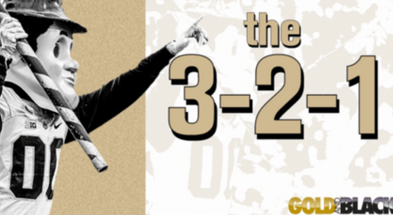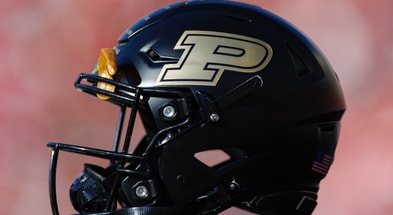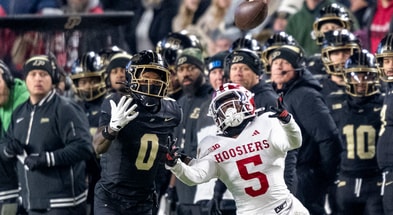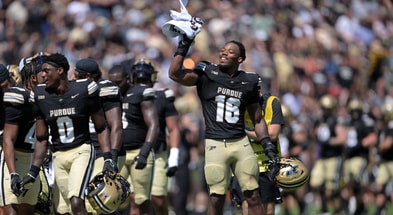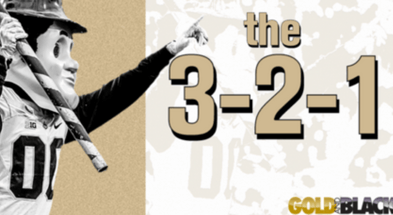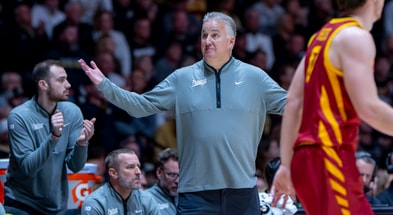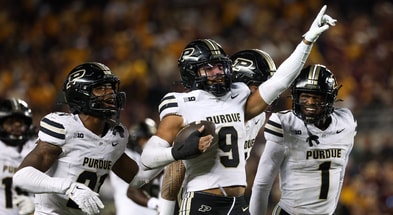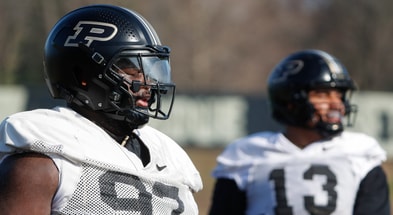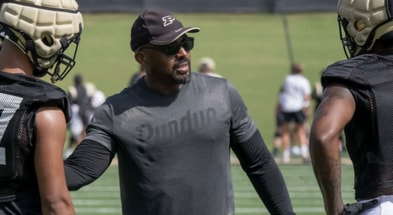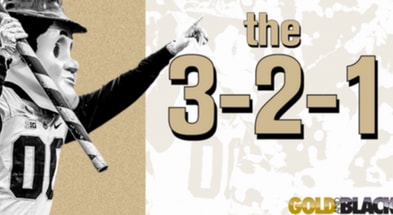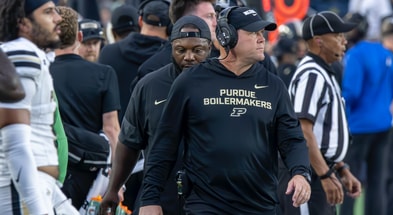Purdue AD Mike Bobinski discusses post-House Settlement landscape: Five things to know
Monday afternoon, Boilermaker athletic director Mike Bobinski met with a gaggle of local media to discuss for the first time in-depth the new landscape of college sports following the House Settlement and how it will affect Purdue.
Here are notables from Bobinski’s message.
ON REVENUE SHARING
Purdue, as been public knowledge for months, will meet the full $20.5-million threshold in Year 1 of revenue sharing and is committed to meeting the rising number annually, with the university pledging for at least the next three years to help with whatever resources might be needed to get there.
“It’s not a black-and-white, ‘Here’s a very specific identification of dollars,'” Bobinski said.
Back when it was first evident that revenue-sharing was forthcoming, per Bobinski, universiy president Mung Chiang and the Board of Trustees made it known it that it was, “very important to the university that we fully participate in the cap” and that “we not do it halfway.”
So the deal is this, according to Bobinski: The athletic department is charged with generating as much of the needed revenue as possible. The university will make up the difference to max it out. Bobinski deferred to Hovde Hall on the particulars.
Point being, though: Purdue has committed to the full allowance for at least several years, with the knowledge that “you’re either all in or you’re out,” as Bobinski articulated to the administration on the ground floor of these decisions.
HOW PURDUE WILL SPLIT MONEY
Purdue isn’t going to divulge exact numbers or percentages, but Bobinski said that four sports will primarily participate in revenue-sharing, none of them being surprising.
Football, as will be the case everywhere that has football, with consume the majority of the money, with men’s basketball being the second most.
“That’s where the revenues are generated,” Bobinski said. “You can agree or disagree but that’s a fact.”
A general template many programs have followed, mirroring NIL backpay settlement splits, put football at 75 percent of the revenue outlay and men’s basketball getting 15 percent. Bobinski said Purdue is probably slightly below those splits in football, but above them in basketball. (This is an uncommon year for basketball, which has a huge senior class, at least two All-Americans and one international recruit who had to buy out his pro contract overseas.)
Women’s basketball and volleyball will be the two women’s sports with shares, but notably, Purdue is holding a $300,000 “unallocated” stash of cash to “recruit or retain elite-level athletes,” presumably in sports outside the four funded programs. That might mean national champions or Olympians in sports like wrestling, track or swimming and diving. Bobinski said a “petition” process will determine how that money is rationed, if used at all, jokingly comparing the dynamics involved to “The Hunger Games.”
ON PURDUE’S APPROACH
Bobinski said Purdue was “aggressive” during the end of unregulated NIL Era, and that aggressiveness resonated around the department and with fans.
“It was like that didn’t feel like Purdue of old times, but that’s what needed to happen,” Bobinski said.
That might have reflected a shift around a traditionally conservative athletic department, especially pre-Bobinski.
“It’s not the old thing where if you need three, can you do it with one?” Bobinski said. “If you need three, you need three.”
ON PREVENTING CAP CIRCUMVENTION
Bobinski has long been a good soldier for the NCAA and joked Monday about perhaps being “idealistic” about the newly formed enforcement structure designed to prevent Name-Image-Likeness excess from knee-capping revenue-sharing limits.
Long story short: The new College Sports Commission will assume enforcement responsibilities, with the accounting firm Deloitte involved in auditing NIL deals, which must be reported via an app.
Top 10
- 1Breaking
Beau Pribula
Mizzou QB to transfer portal
- 2New
ESPN sublicenses CFP
NFL schedule conflict looms
- 3
D'Anton Lynn
Big Ten rival targeting Trojans DC
- 4Trending
Mugshot
Sherrone Moore booking photo
- 5
Kirby Smart
9-game schedule could cost SEC
Get the Daily On3 Newsletter in your inbox every morning
By clicking "Subscribe to Newsletter", I agree to On3's Privacy Notice, Terms, and use of my personal information described therein.
As with every rule the NCAA in its prior form never seemed able to effectively enforce, circumvention is a concern.
“There have been innumerable conversations and speculation about that very thing, so no doubt that’s an issue,” Bobinski said. “… There’s been lots of effort and energy put into anticipating how folks might try to work in the dark allies on this and how to prevent it. And if you don’t prevent it, but do uncover it, then the penalties have to be timely, swift and severe. They’ve got to be behavior-changing.”
The NCAA, contrary to what general perception may be, is not made up of just executives and policy wonks in Indianapolis, but rather conglomerations of university presidents, faculty, athletics reps and so on.
It does beg the question: Do big-money, big-name programs really want enforcement, particularly after experiencing the lawlessness of the past several years?
“That’s a great question,” Bobinski said. “We have all sat in the rooms, both in our Big Ten (meetings) and when we met jointly with the SEC, and it was the conversation where everybody raised their hand and, I believe were sincere about it. We said, ‘Hey, we have to agree to be governed. We have to agree to want to be governed.'”
ON BARRY ODOM AND MATT PAINTER
Bobinski said this about his two flagship-program coaches existing in this new world …
“You all know Matt well and I think Barry is cut from a very similar strain of cloth here. They’re not interested in transactions. It’s still got to be about the core reasons that young people come to college, and particularly come to Purdue. If you’re not in for the whole experience, if you’re just coming here because we’re going to give you some money, this is not going to work very well. That’s going to show itself in a way that’s not going to fit in with the overall expectations and standards and environment that our coaches want to create.”
OTHER DETAILS
• It will be up to coaches and their staffs themselves to determine how their athletes are paid, how often, etc. Athletes sign memorandums of understandings, for lack of a better term, that can cover multiple years — Purdue has only done one-year agreements thus far — and can include such layers as buyouts, conduct clauses, etc.
Revenue-sharing money will be skimmed off media-rights outlay, directed to a Big Ten-commissioned third-party service to make payments to the athletes.
• The private-equity option some schools have considered, if not pursued, is a hard no for Purdue. It is not being considered.
• No non-revenue sports are at risk, but Bobinski said that some non-conference schedules will be crafted with finances in mind. He cited soccer, which will play in only Indiana, Illinois or Ohio prior to Big Ten season. In 2023, Purdue soccer played at pre-Big Ten USC, then Colorado. The year prior included games at Kentucky, Kansas and Kansas State.
Bobinski did concur with the assessment that there may be modest advantage for Purdue in its small number of sports, just 17 traditional-sport programs, and lack of really any Olympic sport programs on par with, for examples, Penn State and Iowa wrestling, Nebraska or Penn State volleyball (though Purdue is competitive there) or Minnesota hockey, all major sports that draw significant fans at their respective schools that will require rev-share investment.


